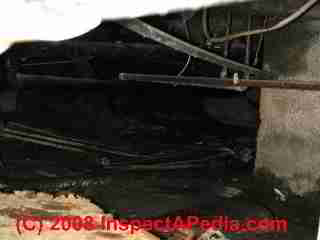Moisture Control in the Crawl Space
Bill Mashek Northwest Termite and Pest Control Inc.
Excessive moisture in a crawl space can be a serious problem, especially if ventilation is not adequate. When water evaporates, there is no place for it to go. Subsequently, the water will condensate on wood underpinnings. Over time, the living organisms in the water will use the wood as a substrate to grow on. This situation can lead to early decay by fungus and infestation by other wood destroying organisms. There are no permanent solutions to eliminate moisture in a crawl space but there are ways to control moisture.
Standing Water 

The best solution for standing water is to divert the outside flow. This can be accomplished with perimeter drainage. If perimeter drainage isn’t possible or the cause of standing water is super saturation i.e. adobe soil a sump pump is probably your best option. A sump pump should be installed in a proper cistern with drain holes on the bottom and side. One can make a simple cistern with a 5 gallon bucket and drilling ¼” holes in the bottom and sides, dig out a large area in the lowest section of the sub structure. The hole should be as deep as the bucket/cistern with twice the circumference. Drain rock should be placed below the bucket and after bucket is set, fill in the perimeter. Wiring a sump pump should be done by a licensed electrician as this should be a dedicated line with a 20 amp circuit.
When installing the sump pump, also install a check valve to prevent back flow. Install a hose and direct drainage beyond exterior of building. Installing drain lines or digging V groves in the soil to direct water flow to the cistern is a prudent option.
Once standing water is under control and we are only dealing with wet to wet and muddy soil, we can now install the vapor barrier. The membrane used as a vapor barrier is black plastic sheeting with a minimum thickness of 6 mil. A vapor barrier will not reduce soil moisture but will lower the humidity in the crawl space. Water will condense on the membrane and stay in the soil instead of evaporating and absorbing into substructure framing. The vapor barrier should cover at least 75% but no more than 90% of the sub area soil. It does not have to be fastened to the foundation wall. Beware of the mold opportunists who want to sell you a $10-12,000+ fancy vapor barrier system.
Other ways to help with excessive moisture conditions is to add mechanical ventilation ( www.tempvent.com) and/or substructure dehumidifier (http://www.crawlspacedehumidifiers.com/).
Thanks for sharing this article, its been a really interesting read. I have actually never head of crawl space moisture control Jacksonville NC before. I really enjoy learning new things, whats best in my opinion is getting to actually try them. I love learning hands on.
ReplyDelete